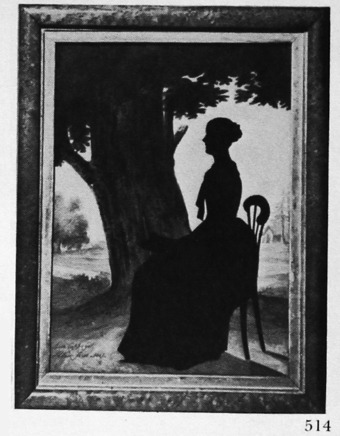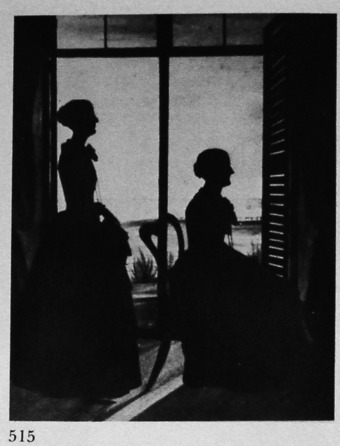Kerr, Louisa, Lady (McKechnie Section 1)
See also Section Six
Recorded by Jackson (Dictionary). It seems that Lady Louisa was a talented amateur artist who, early in her career, painted on ivory, and later cut portraits of her friends which she pasted on to painted backgrounds.
It has previously been suggested that the artist was Harriet Louisa, daughter of the Sixth Marquess of Lothian, who married Sir John Stuart Forbes, Baronet, in 1834. Silhouettes on ivory painted before this year, signed ‘L. L. Kerr’, have been seen. but other silhouettes, produced many years after Harriet Louisa's marriage, and yet bearing the same signature, have also been seen. Another factor weighing against the identification is that all the known signatures lack the initial ‘H’. It seems to me more likely that the artist was Letitia Louisa, born in the early 1800s, eldest daughter of the third son of the Fifth Marquess of Lothian and of the Countess of Antrim. Since she did not marry, she would have retained the name L. L. Kerr throughout the period during which the silhouettes were cut and painted. Harriet Louisa's signature, after her marriage in 1834, would surely have been H. L. Forbes.
It is interesting that Lady Louisa's mother was in fact Countess of Antrim in her own right. Her sister first succeeded to the title, as the Countess’ father had no male heirs, and the title devolved by special limitation to each of the two sisters in turn. Lady Louisa's two eldest brothers were thus also Earls of Antrim in turn.
I have illustrated a full-length profile of Lady Charlotte Chetwynd and Lady Mary Hood, daughters of the Marquis of Downshire. This is inscribed with the names of the sitters and signed ‘L. L. Kerr, August 27th., 1853’. Mr R. Kilner, who owns this profile and the other illustrated example, has seen another double full-length silhouette (signed ‘L. L. Kerr, 1847’), as well as bust-length portraits of Serpina Atherley and Isabella Jane Catherine Atherley (each inscribed on the back ‘Cut by Lady Louisa Kerr, Heavitree, September, 1846’). Mr Kilner also owns silhouettes of Lady Mary Hood and Lady Charlotte Chetwynd, as girls, cut by Edouart. Jackson states that two silhouettes by Lady Louisa are listed in the Catalogue of Portraits, etc. belonging to the Fourth Earl of Liverpool (1905). She also records two other silhouettes: one, of Lady Alice Hill, pasted against the painted background of a Hampstead view; the other, of an unknown woman seated at a piano, with a window in the background giving a view of an Italian scene.
That Lady Louisa was producing silhouettes as early as 1825 is evident from three silhouettes by her, dated 1825, sold by Sotheby and Company, London, on 26 February 1973. Three more examples by Lady Louisa, one dated 1835, were sold on the same occasion. She was still producing work as late as 1868, for Mr and Mrs J. H. Gutteridge own a signed profile, dated this year, of Emily Napier, wife of General William Napier, with her son. Between 1825 and 1868 the artist probably produced silhouettes only intermittently, since not many examples have survived. She may also have been a talented amateur landscape or flower painter, to judge from the painted backgrounds of some of her cut silhouettes.
Most of Lady Louisa's full-length figures were elegantly produced; the plain black figures are well cut and pasted on to a well painted background. Some of the work, however, is cut from shiny paper and looks a trifle clumsy against the background. The cut silhouettes themselves, however, are not intrinsically outstanding and depend on the background for most of their appeal. The bust-length examples (plain black profiles, cut either from dull or shiny paper) are not of great merit.
As it seems doubtful that Lady Louisa used her talent commercially, trade labels are unlikely to be found. Full-length examples are usually signed (often with the date) on the front, and inscribed with the name of the sitter. Bust-length work is often signed (sometimes on the back).
Ills. 514, 515

Jane Cuppage
Cut silhouette, with painted background
1847
8 x 6in./204 x 153mm.
Frame: maple
Cut from shiny black paper and pasted onto an effectively painted, if smudgy, background showing an outdoor scene.
Inscribed ‘Jane Cuppage/L. L. Kerr fecit 1847.’
R. Kilner collection

Lady Charlotte Chetwynd (left) and Lady Mary Hood
Double cut silhouette with painted background
27 August 1853
Signed ‘L. L. Kerr’, with the date. The painted background is typical of the artist’s work.
R. Kilner collection
